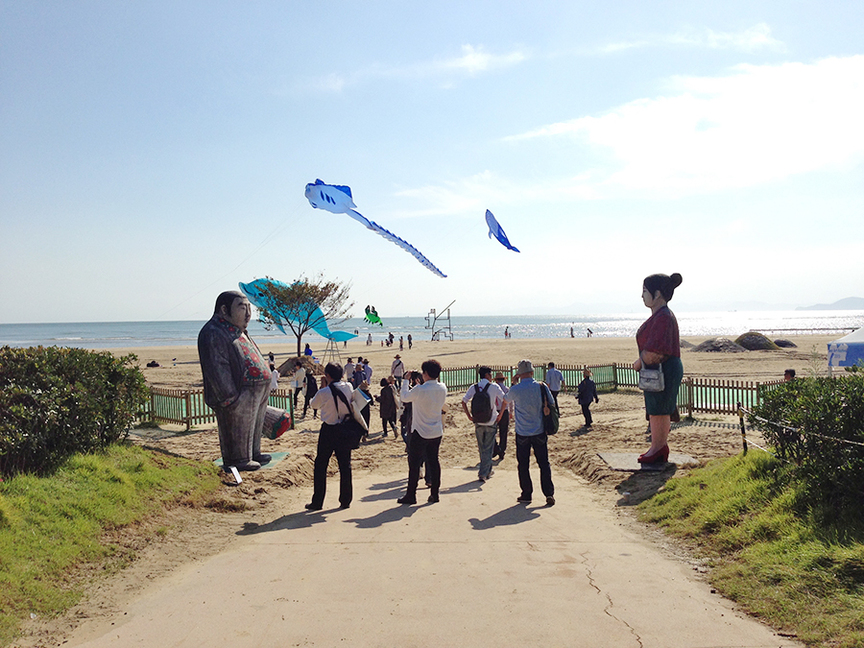Main Dadaepo Beach entrance overlooking the 2015 Sea Art Festival (SAF). Greeting visitors are two figurative sculptures by WON-GEUN KIM, characters that reminded the artist of two mysterious guests that arrived at the artist’s childhood home when he was little, whose presence caused his parents to fight after their departure. He never found out who they were. Flying overhead are kites of sea creatures by PETER LYNN KITES, a SAF special exhibition.
View of 2015 Sea Art Festival on Dadaepo Beach, Busan.
MYOUNG-HO LEE makes use of Dadaepo Beach’s shallow sea, which for 300 meters from the coast is only 1.5 meters deep. With canvasses placed behind rocks on the shore, the rise and fall of the tide change the “painting” compositions.
MYOUNG-HO LEE, Dadaepo Stone (2015). For the artist, this work allows “nature to paint a picture on canvas.”
In the foreground is Polish artist LUDWIKA GRAZYNA OGORZELEC’s Mirror, 2015, made from cellophane and steel, which uses the ropes to visualize drawing in three-dimensional space. The concept of time also impacts this work as given the changing tides, the work sometimes is difficult to get to.
Inspired by the South Bay salt evaporation ponds of San Francisco, which allows salt to be extracted from the sea water, the artist group VGABS, consisting of members from the United State, Korea, France and Russia, created four Imaginary Salt Ponds (2015). Each vibrant color is derived from organic materials such as charcoal, red beet, pine flower powder and green tea.
British artist JONATHAN PAUL FOREMAN uses found objects from Dadaepo Beach to create land art. Here, stacked rocks are an example of the artist’s subtle interventions.
Crossing over the stream to the Daedaepo Beach viewing deck.
Viewing deck of Daedaepo Beach.
Local Daedaepo resident cleaning his fishing boat.
Dutch artist CORNELIS ALBERTUS OUWENS’s Echoes of the Sea (2015) made from hollow steel beams, steel wires and rods. When the wind brushes against the steel wires, the vibration travels into the the hollow steel beams. Here, visitors are listening to a low hum that originated from the the sea wind.
SARAWUT CHUTIWONGPETI from Thailand describes his dream-like installation that is displayed within a shipping container. By painting all of his objects in white, he disassociates the items from their function, creating an ambiguity that allows for broader interpretation.
A participatory work by SUN CHOI asked foreign workers from Ansan, a city known for its migrant population, to paint on a nine-meter-wide canvas using their breath as a way to make visible the invisible. Visitors are trying out the method of blowing the ink.
Container display by Indian artist CHINTAN UPADHYAY who has recycled three derelict cars and has turned them into planters, playing off the idea of transporting seeds of Mother Nature and also of art.
CHINTAN UPADHYAY’s Engender (2015) installation was made together with local Daedaepo residents who contributed their plants. One woman looks on, as if spotting her plant among the bursting assortment of foliage.
Tibetan artist TENZING RIGDOL continues his nomadic soil project: this time, over the course of three days, gathering soil from cities close to the Korean demilitarized zone and bringing it to Busan.
Detail of TENZING RIGDOL’s work Bags Full of Warm Wishes (2015), where each soil bag is marked with the city in which the earth is collected—here, we see cities Incheon, Panju and Gangwhado Island—as well as the date of collection.
DORIT CROISSIER’s Earth Mound (2015), a hollow tower constructed with unfired clay. During the performance where the fire is lit, the heat will harden the bricks making it resistant to the dampness of the sea air.
Italian artist MATTIA LULLINI’s sea-inspired mural on the facade of a nearby building comes together with fluid forms.
A Green Horizontal Line (2015) by WONG-GIL JEON is made from planters of barley sprouts that will grow and meet the horizon of the sea during the course of the festival. For the artist, this is a gesture of coming together for man and nature.
Budapest-based JOSEPH TASNADI’s Persistence of Memory (2015). A detail of the work that prompts different impressions with the rise of the tide. When the tide is high the work seems to float on water. The artist has said that this expression of change prompts visitors to be responsive and inquisitive of their environment.
When the sun sets on Daedaepo Beach, a strip of Korean barbecue stalls come to life.
The next day, back at Daedaepo Beach for the official Sea Art Festival opening. Around the park, residents have organized children’s performances.
Daedaepo Beach Park leads one into the main shorefront where the Sea Art Festival is held.
VIPs gather for the official opening announcement at Daedaepo Beach Park.
The arrival of the ceremony’s guest of honor, Busan mayor Suh Byung-soo.
Participating artists of 2015 Sea Art Festival.
On the opening day of the Sea Art Festival, Daedaepo Beach was filled with people enjoying the sea and interacting with the installations.
Visitors writing wishes for YOKO ONO’s Wishing Tree, a project she began in 1996.
YOUNG-WON KIM’s Shadow of Shadow (alone) (2010), an 8-meter-tall bronze statue that can be seen as the front of the figure from all sides.
Love: 1000 Dreams (2015) is JU-HWAN NOH’s collaborative project with children who created over 1,000 pinwheels with their dreams and wishes written on each one.




